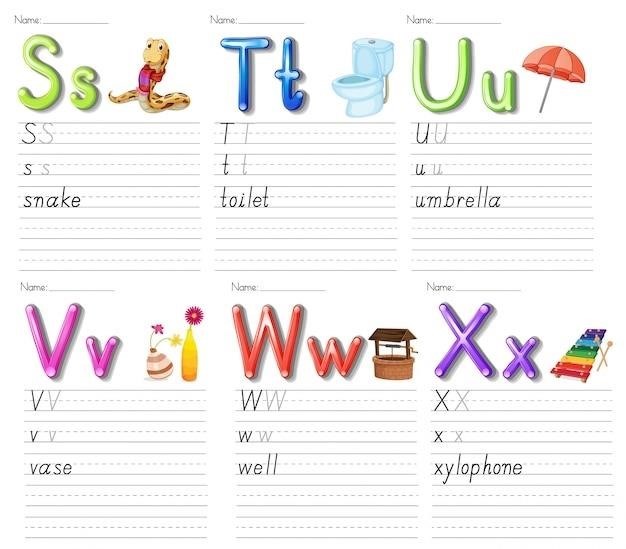alphabet pdf chart

Alphabet PDF Charts⁚ A Comprehensive Guide
Alphabet PDF charts are valuable resources for learning and teaching the alphabet. They offer a visual and interactive way to introduce letters, sounds, and basic vocabulary. These charts are widely used in preschools, kindergartens, and even for homeschooling. This guide will explore the different types, features, benefits, and uses of alphabet PDF charts.
Introduction
In the realm of early literacy, the alphabet holds a pivotal position, laying the foundation for reading and writing skills. Alphabet PDF charts have emerged as invaluable tools for educators and parents alike, offering a visually engaging and interactive means to introduce and reinforce the letters of the alphabet; These digital resources provide a convenient and accessible way to learn and practice letter recognition, phonics, and basic vocabulary. Whether used in classrooms, homes, or for individual learning, alphabet PDF charts offer a diverse range of benefits, catering to different learning styles and educational needs.
These charts are essentially digital representations of traditional alphabet charts, often featuring colorful illustrations, engaging graphics, and interactive elements. They can be easily downloaded, printed, and displayed in various settings. The versatility of alphabet PDF charts lies in their adaptability to different age groups and learning levels, making them a valuable resource for preschoolers, kindergartners, and even older learners who need additional support with letter recognition.
The availability of numerous free and paid alphabet PDF charts online further enhances their accessibility. They provide a convenient and cost-effective solution for educators and parents seeking engaging learning materials. Whether you’re looking for a basic alphabet chart, one that incorporates phonics sounds, or a chart with additional activities, there’s a wide range of options to choose from.
Types of Alphabet Charts
Alphabet PDF charts come in a variety of styles and formats, catering to different learning preferences and educational objectives. Understanding the different types available can help you choose the most appropriate chart for your needs. Here are some common types of alphabet PDF charts⁚
- Basic Alphabet Charts⁚ These charts simply display the uppercase and lowercase letters of the alphabet in a clear and straightforward manner. They are ideal for introducing the alphabet to young learners or for use as a reference tool.
- Phonics Alphabet Charts⁚ These charts incorporate the sounds associated with each letter, often using phonetic symbols or illustrations to represent the different sounds. They are particularly useful for teaching phonics and helping children develop sound-letter correspondence.
- Illustrated Alphabet Charts⁚ These charts feature illustrations of objects or animals that begin with each letter, making the learning process more engaging and memorable. They can help children associate letters with specific words and concepts.
- Interactive Alphabet Charts⁚ These charts include interactive elements, such as clickable letters, pop-up definitions, or sound recordings. They can make learning the alphabet more engaging and interactive.
- Thematic Alphabet Charts⁚ These charts focus on a specific theme, such as animals, transportation, or food. They can help children learn about different topics while also reinforcing letter recognition.
The choice of alphabet chart ultimately depends on the specific learning goals and the age and learning style of the learner. Consider the purpose of the chart, the learner’s needs, and the available resources when making your selection.
Alphabet Chart Features
Alphabet PDF charts come equipped with various features designed to enhance learning and engagement. Understanding these features can help you choose a chart that aligns with your specific needs and teaching approach. Here are some common features to look for in alphabet PDF charts⁚
- Uppercase and Lowercase Letters⁚ Most alphabet charts include both uppercase and lowercase letters, allowing children to learn both forms simultaneously. This is important for developing handwriting skills and recognizing letters in different contexts.
- Letter Sounds⁚ Many charts incorporate phonetic information, providing children with the sounds associated with each letter. This is crucial for developing phonemic awareness and sound-letter correspondence.
- Illustrations⁚ Illustrated charts use pictures to represent words that begin with each letter, making learning more visual and engaging. These illustrations can help children remember letter-sound associations and connect letters to real-world objects.
- Color Coding⁚ Some charts use color coding to differentiate between vowels and consonants, making it easier for children to categorize letters and understand their different functions.
- Stroke Order Guides⁚ Charts designed for handwriting practice may include stroke order guides that show the correct sequence of strokes for forming each letter. This can help children develop proper letter formation and handwriting skills.
- Printable Format⁚ The PDF format makes it easy to print and distribute alphabet charts. This allows for flexible use in classrooms, homes, or for individual learners.
By carefully considering the features of different alphabet PDF charts, you can find the perfect resource to support your learning goals and enhance your child’s alphabet knowledge.
Benefits of Using Alphabet Charts
Alphabet PDF charts offer numerous benefits for both children and educators, making them valuable tools for early literacy development. Here are some key advantages of incorporating alphabet charts into your learning environment⁚
- Visual Learning⁚ Charts provide a visual representation of the alphabet, which is particularly helpful for visual learners. The combination of letters and images reinforces letter recognition and sound-letter association.
- Interactive Learning⁚ Alphabet charts can be used in interactive activities, such as pointing to letters, reciting the alphabet, or playing games like “I Spy” with letter sounds. This engagement promotes active learning and makes learning more enjoyable.
- Reference Tool⁚ Charts serve as a handy reference tool for children to look up letters, sounds, and words. This self-reliance encourages independent learning and exploration.
- Support for Literacy Development⁚ Alphabet charts provide a foundational basis for literacy skills, such as letter recognition, phonemic awareness, and sound-letter correspondence. These skills are essential for reading and writing development.
- Accessibility and Affordability⁚ PDF charts are readily available online and are often free or inexpensive, making them accessible to everyone. This allows for easy printing and distribution for individual use or classroom settings.
By incorporating alphabet PDF charts into your learning activities, you can create a fun and engaging environment that fosters early literacy development and helps children build a strong foundation for reading and writing.
Alphabet Chart Uses in Education
Alphabet PDF charts are versatile educational tools that can be incorporated into a variety of learning activities. Their applications extend beyond simple letter recognition and encompass a range of educational purposes. Here are some common uses of alphabet charts in education⁚
- Classroom Decor⁚ Printed alphabet charts can be displayed prominently in classrooms as visual aids. This helps children become familiar with the letters and sounds of the alphabet and provides a constant reference point for learning.
- Guided Reading⁚ Teachers can use alphabet charts during guided reading sessions to help students identify letters, sounds, and words. The charts can be used as a visual aid to support decoding and comprehension.
- Phonics Instruction⁚ Alphabet charts are invaluable for teaching phonics, which involves the relationship between letters and sounds. Charts can be used to illustrate the sounds of individual letters, blends, and digraphs.
- Word Work Activities⁚ Alphabet charts can be incorporated into word work activities, such as sorting words by beginning sounds, creating word families, and building vocabulary.
- Writing Activities⁚ Charts can serve as a reference tool for children who are learning to write. They can look at the chart to check the correct spelling of words or to practice forming letters.
- Assessment⁚ Teachers can use alphabet charts to assess students’ understanding of letter recognition, sound-letter correspondence, and vocabulary.

Alphabet PDF charts are a valuable asset for educators who are seeking to create engaging and effective learning experiences. They provide a flexible tool that can be adapted to various educational settings and learning styles.
Printable Alphabet Chart Resources
The internet offers a wealth of free and printable alphabet chart resources that cater to various learning styles and preferences. These resources provide educators and parents with a convenient way to access high-quality alphabet charts without the need for expensive commercial materials. Here are some popular online platforms and websites that offer printable alphabet charts⁚
- Educational Websites⁚ Websites dedicated to early childhood education often provide free printable alphabet charts. These charts may feature colorful illustrations, simple letter forms, and phonetic sounds. Some websites also offer customizable charts that allow users to choose specific colors, fonts, and themes.
- Teacher Resource Sites⁚ Teacher-specific websites offer a wide range of printable resources, including alphabet charts. These charts are often designed with classroom use in mind and may include additional features such as word lists, phonics activities, and lesson plans.
- Free Printable Resources⁚ Many websites specialize in providing free printable resources, including alphabet charts. These websites offer a diverse range of chart styles, from basic black and white designs to colorful, interactive charts.
- Creative Commons Resources⁚ Creative Commons websites allow users to access and share copyrighted content, including printable alphabet charts. These charts may be available under various licenses, allowing users to adapt, modify, and distribute them for educational purposes.
When choosing printable alphabet chart resources, it’s important to consider the age and learning level of the intended audience, as well as the specific learning goals. By exploring the vast array of available options, educators and parents can find alphabet charts that effectively support early literacy development.
Alphabet Chart Styles and Formats
Alphabet PDF charts come in a variety of styles and formats to suit different learning preferences and educational needs. From simple black and white designs to colorful and interactive charts, there’s a style to engage every learner. Here’s a breakdown of some common alphabet chart styles and formats⁚
- Traditional Alphabet Charts⁚ These charts typically display the uppercase and lowercase letters of the alphabet in a sequential order, often with a simple illustration or picture representing each letter. They may include phonetic sounds or word examples for each letter.
- Illustrated Alphabet Charts⁚ These charts feature more elaborate illustrations for each letter, often depicting animals, objects, or scenes related to the letter’s sound. They can be visually appealing and help children associate letters with specific words and concepts.
- Phonics-Based Alphabet Charts⁚ These charts emphasize the sounds of letters and often include phonetic symbols or diagrams to illustrate the different sounds a letter can make. They are particularly useful for teaching phonics and decoding skills.
- Interactive Alphabet Charts⁚ These charts incorporate elements that encourage engagement and active learning. They may include movable pieces, flaps to reveal letters, or interactive games that help reinforce letter recognition and sounds.
- Thematic Alphabet Charts⁚ These charts focus on a specific theme, such as animals, transportation, or food. They present the alphabet within the context of the theme, making learning more engaging and relevant.
The choice of alphabet chart style and format depends on the age, learning style, and specific needs of the learner. By exploring the diverse range of options, educators and parents can find charts that effectively support alphabet learning and literacy development.
Creating Your Own Alphabet Chart
Creating your own alphabet chart can be a fun and rewarding experience. It allows you to personalize the chart to meet the specific needs and interests of your child or students. With a little creativity and some basic design skills, you can create a unique and engaging alphabet learning tool.
Here are some steps to guide you in creating your own alphabet chart⁚
- Choose a Theme⁚ Select a theme that aligns with your child’s interests or the learning objectives you wish to achieve. For example, you could choose a theme based on animals, colors, shapes, or popular children’s books.
- Select Images⁚ Gather images or illustrations that represent each letter of the alphabet within the chosen theme. You can find free images online, use clipart, or even draw your own illustrations.
- Layout and Design⁚ Decide on the layout and design of your chart. You can use a grid format, a spiral design, or a more creative and playful arrangement. Consider using different fonts, colors, and textures to make the chart visually appealing.
- Add Additional Elements⁚ Include additional elements that enhance learning, such as phonetic sounds, word examples, or simple activities related to each letter. You can also incorporate interactive elements like movable pieces or flaps to make the chart more engaging.
- Create a PDF File⁚ Once you’ve completed the design, save your chart as a PDF file. This will ensure that the layout and formatting remain consistent when printed or shared electronically.
By creating your own alphabet chart, you can tailor it to your child’s specific learning style and preferences, fostering a more personalized and engaging learning experience.
Alphabet Chart for Different Languages
Alphabet charts are not limited to the English language. They are essential tools for learning and teaching alphabets in various languages around the world. Many online resources offer alphabet charts in different languages, catering to diverse cultural and linguistic backgrounds.
For instance, you can find alphabet charts for languages such as Spanish, French, German, Italian, Russian, Chinese, Japanese, and many others. These charts often feature the letters in uppercase and lowercase, alongside pronunciation guides, examples of words, and even phonetic symbols to aid in pronunciation.
Learning a new language can be more engaging and interactive with the use of alphabet charts. These charts provide a visual representation of the alphabet, making it easier to remember the letters and their sounds. They can also be used for practicing writing, spelling, and reading in the target language.
Whether you are a language learner, a teacher, or a parent seeking to introduce your child to a new language, alphabet charts for different languages offer a valuable resource for enhancing language learning. By utilizing these charts, you can effectively learn and teach alphabets in diverse linguistic contexts, enriching your understanding and appreciation of different cultures and languages.



Leave a Reply
You must be logged in to post a comment.